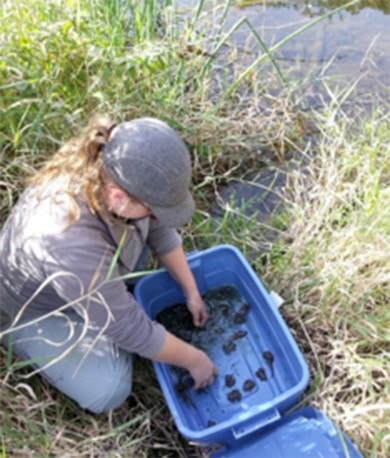On Thursday, Oct. 3, the Greater Vancouver Zoo was thrilled to release 325 Oregon spotted frogs back into the wilds of Agassiz.
This project has been a very important part of the zoo’s conservation efforts since the frog received the status of “critically endangered” in 1999. The Oregon spotted frogs are the most endangered amphibian in Canada.
The Greater Vancouver Zoo provides a “head start” program that involves removing egg masses from the wild and then raising the frogs in a captive environment until they are large enough to be released. This has proven to have a much higher survival rate than the embryos, tadpoles and small frogs would see in the wild.
This is the third year that the Oregon spotted frog recovery team has released frogs to the Chaplin site in Agassiz. The hopes with releasing such large numbers several years in a row to the same site would be to see the first egg masses next year in this area.
Oregon Spotted Frogs are medium-sized (approximately 5-10 cm) and named for the black blotches with light centres that are distributed across the head and back of adult frogs. These spots become larger and ragged looking around the edges as the frog ages. They also have a pair of parallel, light brown to orange ridges which are called dorsolateral folds that run from just behind the eyes all the way down their back.
Juveniles are light brown or olive green on their back and white to cream on their belly. Their mating call consists of a series of 5-50 clucks that sound like knocking on a log, or someone softly clicking their tongue on the roof of their mouth.
There has been a big decline in numbers due to the area being inhabited by the introduced bullfrog, green frogs and predatory fish that compete with the Oregon spotted frog for food and their habitat. Reed canary grass is an invasive plant that can also change the frog’s habitat. Also the loss and degradation of breeding habitat from dam construction, drainage patterns being altered, excessive livestock grazing, agricultural use for water and other human activities that reduce or eliminate shallow water.
Oregon spotted frogs spend most of their time in shallow calm waters, usually floodplains and wetlands; especially ponds that has sunlight that warms the water.
The Oregon spotted frog recovery team was formed in 1999 when the Committee on the Status of Endangered Wildlife in Canada (COSEWIC) first designated the frog as “endangered” in order to save the species. The species is also red-listed in B.C. The team is comprised of biologists from provincial and federal government agencies, members of CAZA-AZAC (Canada’s Accredited Zoos and Aquariums - Aquariums et Zoos Accrédités du Canada) and other researchers.
